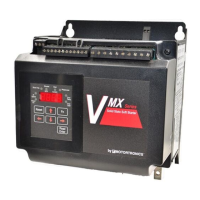Electrical Connections
Power Connections
Referring to local code standards for wire sizing and length, connect
power conductors to the unit input terminals marked L1, L2, L3 (R, S,
T for IEC users). Connection points are bus tabs with pre-drilled
holes (see section 2 of the Advanced Installation, Operation and
Programming Manual). Use appropriate compression or mechanical
lugs for termination to these bus tabs. Avoid routing power wires
over the control board or display. Connect the motor leads to the unit
terminals marked T1, T2, T3 (U, V, W for IEC users). If control power
is present, but line power is disconnected from L1, L2, L3, the
display will show [n3PH] indicating “no 3 Phase”.
Caution!
Never interchange input and output connections to
the unit. This could cause excessive voltage in the
control logic circuit and may damage the unit.
Bypass Contactor
Bypass Contactors are integral (built-in) on all VMX versions. See
sections 1.2.3, 3.1.3.c and Appendix 4 of the Advanced Installation,
Operation and Programming Manual for more details on contactor
control and overload protection details.
Power Factor Correction Capacitors
Power factor correction capacitors can be connected to motors
controlled by VMX Series starters, however they must be off-line
during ramping. Connect PFC capacitors to the Line side of the
starter with a separate capacitor control contactor.
WARNING!
Never connect power factor correction capacitors on the load
side of the unit. The SCRs will be seriously damaged if
capacitors are located on the load side.
Grounding
Connect the ground cable to the ground terminal as labeled on the
unit. Refer to the National Electrical Code or your local Code for the
proper ground wire sizing and be sure that the ground connector is
connected to earth ground. In ungrounded systems, it is not
necessary to connect a ground to the unit however local codes
should always be consulted.

